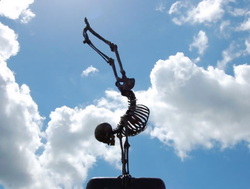 Jenelle Croatto APD Building strong, dense bones in our younger years is essential in preventing osteoporosis later in life. Osteoporosis is a disease which literally means ‘porous bones’ and is caused by mineral loss within the bone at a rate that is faster than the body can replace. Over time bones can become weak and brittle and the risk of fractures is increased. Unfortunately, osteoporosis is often called the ‘silent disease’ as symptoms may not be apparent until a fracture has occurred. Osteoporosis affects over 1 million people in Australia. Women are at a higher risk of developing this disease due reduced levels of oestrogen throughout menopause. As oestrogen levels fall, minerals are lost from the bone at a faster rate, causing bone loss to be approximately 2% each year following menopause[1] By following a diet that contains adequate amounts of calcium rich foods, you can help slow the natural loss of bone with age. From this moment on, make it your priority to do everything in your power to build strong bones for life! CALCIUM Adult men and women require 1000mg of calcium each day to meet their Recommended Daily Intake (RDI). From seventy years of age and onwards the RDI rises to 1300mg. NOTE: 1 serve = 250ml milk, ½ cup evaporated milk, 250ml soy, rice or other cereal drink (with at least 100mg added calcium/100ml), ½ cup ricotta cheese, 40g hard cheese & ¾ cup yoghurt. Dairy rich foods are an excellent source of bio-available (easily absorbed) calcium. Did you know that lactose, the natural sugar in dairy products actually helps your body absorb calcium and that dairy foods contribute around 60% of the calcium we consume. Refer to the following link to learn where calcium is found within the diet (also includes non-dairy sources) http://www.dairynutrition.ca/nutrients-in-milk-products/calcium/calcium-and-bioavailability Calcium is also found within a number of other dietary sources such as leafy green vegetables, calcium enriched soy and tofu, nuts and seeds and fish with edible bones e.g. sardines and salmon and calcium fortified foods e.g. calcium fortified breakfast cereal and bread. VITAMIN D Vitamin D helps the body absorb calcium from the intestine. The easiest way to obtain a sufficient amount of calcium is from direct sunlight exposure. When our skin is exposed to ultraviolet B (UVB) light from the sun our skin produces vitamin D. Many people do not receive enough sunlight to produce sufficient quantities of vitamin D, particularly during winter and for individuals who a house bound. If you are unable to get outside to achieve an adequate exposure of daily sunlight, it is recommended to discuss with your GP about the possibility of taking a vitamin D supplement. Check out the link to Osteoporosis Australia for their recommendations for sunlight exposure. http://www.osteoporosis.org.au/images/stories/reccomended-sun-exposure.pdf ACTIVITY Regular physical activity throughout life is important for maintaining strong bones that will last a life time. Activity, particularly that which places gentle strain on your bones will help them become stronger over time. Examples of exercise which will help benefit your bone strength include: brisk walking, jogging, basketball/netball, dancing, tennis, skipping, star walking, weight lifting and gym equipment. A LITTLE MORE ADVICE - Moderate your salt, alcohol and caffeine intake as an excessive intake can weaken bones. - Follow the ‘Plate Model’ at each main meal to ensure you consume adequate amounts of protein throughout the day: ½ plate non-starchy veg, ¼ plate lean protein, ~1/4 plate low GI carbohydrate and a dash of healthy fat. Protein is a macro-nutrient which also plays a role in building strong bones. [1] Osteoporosis Australia: http:www.osteoporosis.org.au [2] Australian Dietary Guidelines 2003: http:www.nhmrc.gov.au/guidelines/publications/n55
0 Comments
|
News FEEDFitness, Energy, Education & Diet Archives
June 2020
Categories
All
|
 RSS Feed
RSS Feed